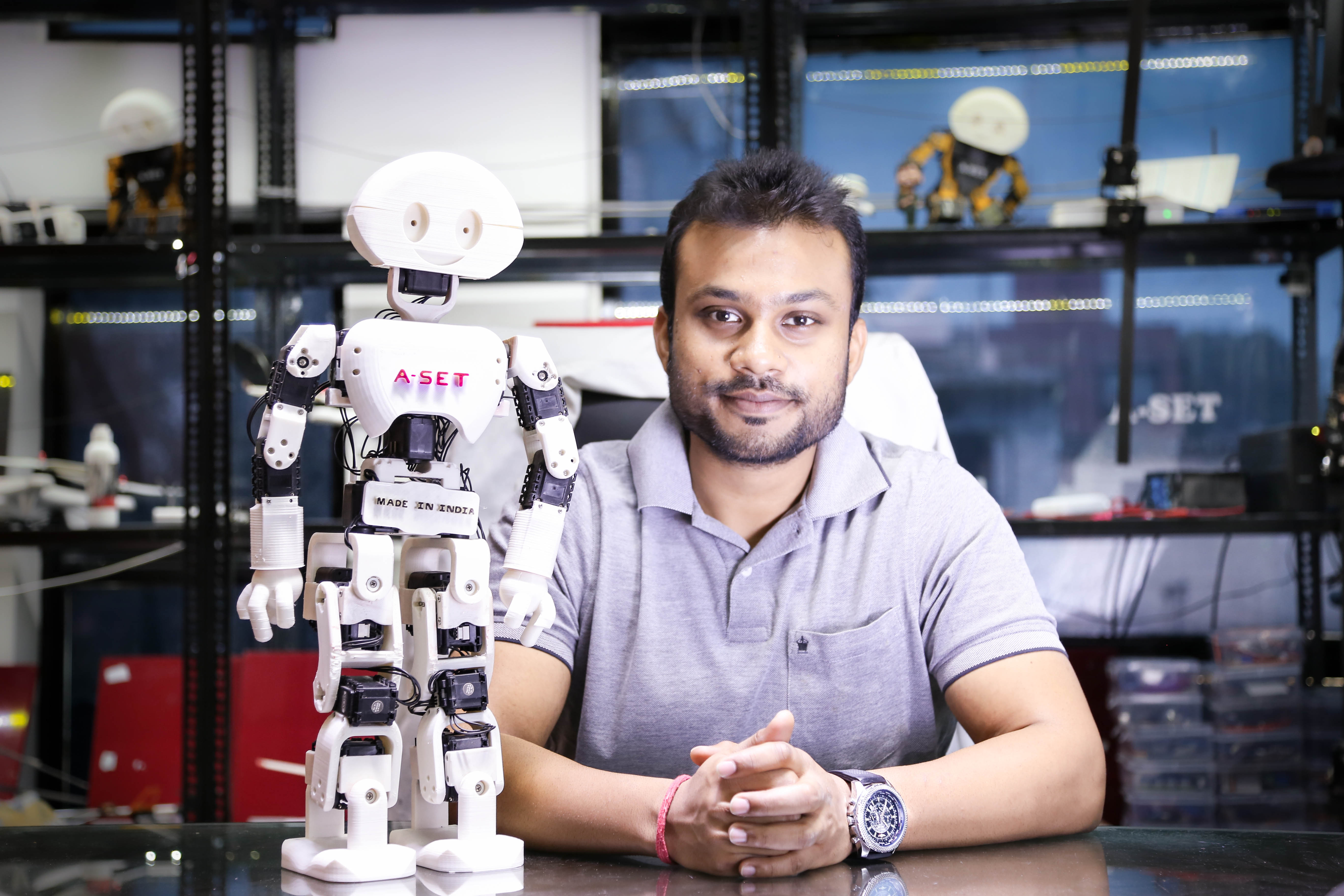|
Mind-controlled Wheelchair
A mind-controlled wheelchair is a mind-machine interfacing device that uses thought (neural impulses) to command the motorised wheelchair's motion. The first such device to reach production was designed by Diwakar Vaish, Head of Robotics and Research at A-SET Training & Research Institutes. The wheelchair is of great importance to patients with locked-in syndrome (LIS), in which a patient is aware but cannot move or communicate verbally due to complete paralysis of nearly all voluntary muscles in the body except the eyes. Such wheelchairs can also be used in case of muscular dystrophy, a disease that weakens the musculoskeletal system and hampers locomotion (walking or moving). History The technology behind brain or mind control goes back to at least 2002, when researchers implanted electrodes into the brains of macaque monkeys, which enabled them to control a cursor on a computer screen. Similar techniques were able to control robotic arms and simple joysticks. In 2009, resea ... [...More Info...] [...Related Items...] OR: [Wikipedia] [Google] [Baidu] |
Diwakar Vaish
Diwakar Vaish ( ; born 23 July 1992) is an Indian born robotics researcher and Head of Robotics and Research at A-SET Training and Research Institutes (2010–present). He is the developer of India's first completely indigenous 3D printed humanoid robot ( Manav), India's first mind controlled robot, and world's first production brain controlled wheelchair. These technologies and robots were developed at the labs of A-SET Training & Research Institutes. Diwakar is the co-creator alongside All India Institute of Medical Sciences, Delhi the world's cheapest ventilator. Achievements * He is the developer and mind behind Manav (India's first completely indigenous 3D printed humanoid robot) * He is an alumnus of Sharda University, Noida. He was part of B.Tech (Computer Science program) from 2010-2014 batch * In 2017, Diwakar Vaish, alongside All India Institute of Medical Sciences, Delhi co-created the world's cheapest and smallest ventilator, the ventilator does not require an artif ... [...More Info...] [...Related Items...] OR: [Wikipedia] [Google] [Baidu] |
Brain–computer Interface
A brain–computer interface (BCI), sometimes called a brain–machine interface (BMI) or smartbrain, is a direct communication pathway between the brain, brain's electrical activity and an external device, most commonly a computer or robotic limb. BCIs are often directed at researching, Brain mapping, mapping, assisting, Augmented cognition, augmenting, or repairing human Cognitive skill, cognitive or Sensory-motor coupling, sensory-motor functions. Implementations of BCIs range from non-invasive (Electroencephalography, EEG, Magnetoencephalography, MEG, Electrooculography, EOG, Magnetic resonance imaging, MRI) and partially invasive (Electrocorticography, ECoG and endovascular) to invasive (microelectrode array), based on how close electrodes get to brain tissue.Michael L Martini, BA, Eric Karl Oermann, MD, Nicholas L Opie, PhD, Fedor Panov, MD, Thomas Oxley, MD, PhD, Kurt Yaeger, MD, Sensor Modalities for Brain-Computer Interface Technology: A Comprehensive Literature Review, ... [...More Info...] [...Related Items...] OR: [Wikipedia] [Google] [Baidu] |
Indian Inventions
This list of Indian inventions and discoveries details the inventions, scientific discoveries and contributions of India, including the ancient, classical and post-classical nations in the subcontinent historically referred to as India and the modern Indian state. It draws from the whole cultural and technological history of India, during which architecture, astronomy, cartography, metallurgy, logic, mathematics, metrology and mineralogy were among the branches of study pursued by its scholars. During recent times science and technology in the Republic of India has also focused on automobile engineering, information technology, communications as well as research into space and polar technology. For the purpose of this list, the inventions are regarded as technological firsts developed in India, and as such does not include foreign technologies which India acquired through contact. It also does not include technologies or discoveries developed elsewhere and later invented sep ... [...More Info...] [...Related Items...] OR: [Wikipedia] [Google] [Baidu] |
Robotics
Robotics is an interdisciplinary branch of computer science and engineering. Robotics involves design, construction, operation, and use of robots. The goal of robotics is to design machines that can help and assist humans. Robotics integrates fields of mechanical engineering, electrical engineering, information engineering, mechatronics, electronics, bioengineering, computer engineering, control engineering, software engineering, mathematics, etc. Robotics develops machines that can substitute for humans and replicate human actions. Robots can be used in many situations for many purposes, but today many are used in dangerous environments (including inspection of radioactive materials, bomb detection and deactivation), manufacturing processes, or where humans cannot survive (e.g. in space, underwater, in high heat, and clean up and containment of hazardous materials and radiation). Robots can take any form, but some are made to resemble humans in appearance. This is claim ... [...More Info...] [...Related Items...] OR: [Wikipedia] [Google] [Baidu] |
Mobility Devices
Mobility may refer to: Social sciences and humanities * Economic mobility, ability of individuals or families to improve their economic status * Geographic mobility, the measure of how populations and goods move over time * Mobilities, a contemporary paradigm in the social sciences and humanities that explores the movement of people, ideas and things ** Individual mobility ** Hypermobility (travel), the social aspects and environmental impacts of excessive travel ** Private transport, e.g., car-based ** Transport *** Sustainable transport, refers to the broad subject of transport that is or approaches being sustainable *** Active mobility (also known as soft mobility), based on non-motorized transportation methods * Social mobility, movement of people between one social classes or economic levels Arts, entertainment, and media * Mobility (chess), the ability of a chess piece to move around the board and chess game * "Mobility" (song), a 1990 song by Moby * ''Mobility'' (video ... [...More Info...] [...Related Items...] OR: [Wikipedia] [Google] [Baidu] |
Neuroscience
Neuroscience is the scientific study of the nervous system (the brain, spinal cord, and peripheral nervous system), its functions and disorders. It is a multidisciplinary science that combines physiology, anatomy, molecular biology, developmental biology, cytology, psychology, physics, computer science, chemistry, medicine, statistics, and Mathematical Modeling, mathematical modeling to understand the fundamental and emergent properties of neurons, glia and neural circuits. The understanding of the biological basis of learning, memory, behavior, perception, and consciousness has been described by Eric Kandel as the "epic challenge" of the Biology, biological sciences. The scope of neuroscience has broadened over time to include different approaches used to study the nervous system at different scales. The techniques used by neuroscientists have expanded enormously, from molecular biology, molecular and cell biology, cellular studies of individual neurons to neuroimaging, imaging ... [...More Info...] [...Related Items...] OR: [Wikipedia] [Google] [Baidu] |
Temperature Sensor
Mechanical temperature sensors * Thermometer * Therm Electrical temperature sensors * Thermistor- Thermistors are thermally sensitive resistors whose prime function is to exhibit a large, predictable and precise change in electrical resistance when subjected to a corresponding change in body temperature. Negative Temperature Coefficient (NTC) thermistors exhibit a decrease in electrical resistance when subjected to an increase in body temperature and Positive Temperature Coefficient (PTC) thermistors exhibit an increase in electrical resistance when subjected to an increase in body temperature. * Thermocouple * Resistance thermometer * Silicon bandgap temperature sensor Integrated circuit sensors The integrated circuit sensors may come in a variety of interfaces — analogue or digital; for digital, these could be Serial Peripheral Interface, SMBus/ I2C or 1-Wire. In OpenBSD, many of the I2C temperature sensors from the below list have been supported and are accessible throug ... [...More Info...] [...Related Items...] OR: [Wikipedia] [Google] [Baidu] |
Sensor
A sensor is a device that produces an output signal for the purpose of sensing a physical phenomenon. In the broadest definition, a sensor is a device, module, machine, or subsystem that detects events or changes in its environment and sends the information to other electronics, frequently a computer processor. Sensors are always used with other electronics. Sensors are used in everyday objects such as touch-sensitive elevator buttons (tactile sensor) and lamps which dim or brighten by touching the base, and in innumerable applications of which most people are never aware. With advances in micromachinery and easy-to-use microcontroller platforms, the uses of sensors have expanded beyond the traditional fields of temperature, pressure and flow measurement, for example into Attitude and heading reference system, MARG sensors. Analog sensors such as potentiometers and force-sensing resistors are still widely used. Their applications include manufacturing and machinery, airplane ... [...More Info...] [...Related Items...] OR: [Wikipedia] [Google] [Baidu] |
Electroencephalography
Electroencephalography (EEG) is a method to record an electrogram of the spontaneous electrical activity of the brain. The biosignals detected by EEG have been shown to represent the postsynaptic potentials of pyramidal neurons in the neocortex and allocortex. It is typically non-invasive, with the EEG electrodes placed along the scalp (commonly called "scalp EEG") using the International 10-20 system, or variations of it. Electrocorticography, involving surgical placement of electrodes, is sometimes called " intracranial EEG". Clinical interpretation of EEG recordings is most often performed by visual inspection of the tracing or quantitative EEG analysis. Voltage fluctuations measured by the EEG bioamplifier and electrodes allow the evaluation of normal brain activity. As the electrical activity monitored by EEG originates in neurons in the underlying brain tissue, the recordings made by the electrodes on the surface of the scalp vary in accordance with their orientation and ... [...More Info...] [...Related Items...] OR: [Wikipedia] [Google] [Baidu] |
Manav (robot)
Manav (Sanskrit: मानव, pronounced "Maanav"/Mɑnʌv, meaning "human") is a humanoid robot developed in the laboratory of A-SET Training and Research Institutes by Diwakar Vaish Diwakar Vaish ( ; born 23 July 1992) is an Indian born robotics researcher and Head of Robotics and Research at A-SET Training and Research Institutes (2010–present). He is the developer of India's first completely indigenous 3D printed humanoi ... (Head of Robotics and Research, A-SET Training and Research Institutes) in late December 2014. It debuted at the IIT-Bombay Techfest 2014-2015 in Mumbai. Technical specifications Manav is 2 feet tall and weights 2 kilograms. It has a rechargeable Lithium polymer battery. Manav's outer body was designed in A-SET's own 3D printing laboratory and is made of Acrylonitrile butadiene styrene plastic. It has a total of 21 degrees of freedom, two of which provide head movement allowing it to nod and look around. 1 degree of freedom goes to the waist which ... [...More Info...] [...Related Items...] OR: [Wikipedia] [Google] [Baidu] |
Muscular Dystrophy
Muscular dystrophies (MD) are a genetically and clinically heterogeneous group of rare neuromuscular diseases that cause progressive weakness and breakdown of skeletal muscles over time. The disorders differ as to which muscles are primarily affected, the degree of weakness, how fast they worsen, and when symptoms begin. Some types are also associated with problems in other organs. Over 30 different disorders are classified as muscular dystrophies. Of those, Duchenne muscular dystrophy (DMD) accounts for approximately 50% of cases and affects males beginning around the age of four. Other relatively common muscular dystrophies include Becker muscular dystrophy, facioscapulohumeral muscular dystrophy, and myotonic dystrophy, whereas limb–girdle muscular dystrophy and congenital muscular dystrophy are themselves groups of several – usually ultrarare – genetic disorders. Muscular dystrophies are caused by mutations in genes, usually those involved in making muscle proteins. ... [...More Info...] [...Related Items...] OR: [Wikipedia] [Google] [Baidu] |


.jpg)






